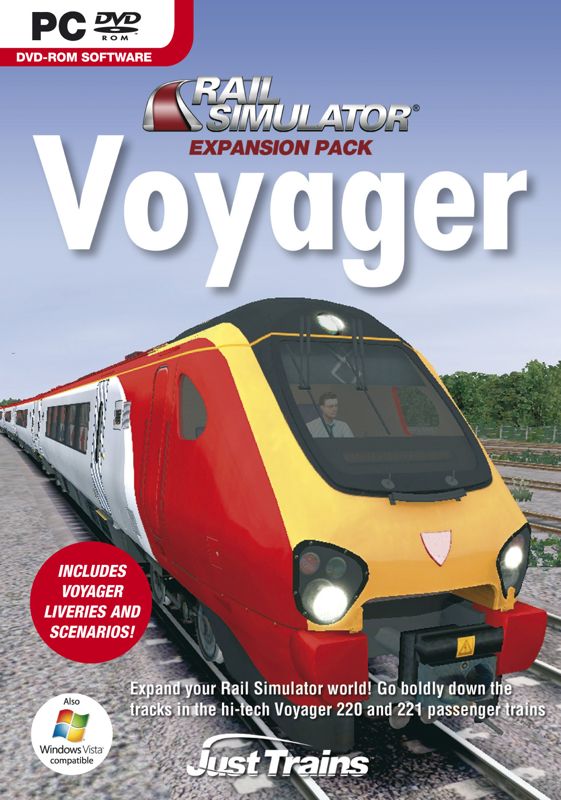Retro Replay Review
Gameplay
The core gameplay of Voyager builds on the solid foundation of Rail Simulator, offering train enthusiasts a more focused and immersive experience. From the moment you sit in the driver’s seat, you’ll appreciate the depth of the controls: throttle levers, brake settings, and realistic safety systems are all faithfully reproduced. Whether you’re a newcomer to train sims or a seasoned veteran, Voyager’s precise handling and authentic responses to track conditions will keep you engaged.
(HEY YOU!! We hope you enjoy! We try not to run ads. So basically, this is a very expensive hobby running this site. Please consider joining us for updates, forums, and more. Network w/ us to make some cash or friends while retro gaming, and you can win some free retro games for posting. Okay, carry on 👍)
One of Voyager’s standout features is the inclusion of both Class 220 and Class 221 varieties. Each locomotive behaves distinctly under load, with subtle differences in acceleration, braking distance, and suspension feel. The add-on’s accurate physics model ensures that every twist of the throttle or tap on the brake lever translates into believable motion. For players who relish fine-tuning their driving style, this level of detail elevates every journey.
Voyager also offers a passenger view mode and seven distinct scenarios that range from routine regional services to challenging high-speed runs. The passenger perspective adds a fresh lens to the gameplay, letting you witness station stops, scenic countryside, and station announcements up close. Completing the scripted scenarios not only teaches you the ins and outs of operating these trains but also provides a sense of progression and accomplishment.
Graphics
Visually, Voyager stands out as one of the more polished add-ons for Rail Simulator. The exterior models of the Class 220 and Class 221 units feature crisp, high-resolution textures that showcase rivets, panel lines, and undercarriage details. Daytime lighting brings out the subtle sheen of the metallic liveries, while dynamic shadowing under bridges and tunnels adds further realism.
Inside the cab, textures remain consistently detailed. The control panels are adorned with legible gauges, tactile-looking buttons, and faithful reproductions of OEM placards. Animations such as the slight bounce of the throttle handle or the smooth slide of the brake lever reinforce the tactile sensation of operating a modern passenger train. Even minor flourishes—like the flicker of indicator lights—demonstrate careful attention to immersion.
Livery options expand the visual appeal, presenting authentic Cross Country, Cross Country Transitional, and Virgin color schemes alongside imaginative ‘what if’ liveries for USA and German operators. Each paint job is accompanied by properly aligned logos, accurate numbering, and weathering effects that vary slightly to prevent a sterile appearance. Whether you’re lining up for a scenic shot or cruising at 125 mph, Voyager’s graphics hold up under close scrutiny.
Story
Although Voyager is not driven by an overarching narrative in the traditional sense, the seven scenarios act as self-contained story beats that guide you through different operating contexts. From pre-dawn departures on regional lines to high-speed runs against the clock, each task presents a mini-narrative—boarding passengers, adhering to timetable constraints, and navigating signal sequences.
The scenarios often craft tension through realistic operational challenges. One mission might have you recovering from a late departure, forcing you to balance speed against passenger comfort. Another scenario places you on a heavily trafficked mainline, where precise adherence to signals and spacing rules is critical. This subtle storytelling through gameplay decisions encourages you to hone your skills and adapt to evolving conditions.
Between departures, ambient announcements crackle over the PA system and station staff bustle along platforms. These atmospheric touches reinforce the sense that you’re part of a living, breathing railway network. While there’s no central protagonist or dialogue-driven plot, the combination of sound design, scenario objectives, and real-world station environments weaves a cohesive operational narrative.
Overall Experience
As an add-on to Rail Simulator, Voyager delivers a focused, high-quality expansion that will please fans of modern passenger trains. Its combination of authentic physics, detailed models, and scenario-driven challenges makes it a worthy investment for those seeking to deepen their understanding of Class 220 and 221 operations. The add-on’s reliance on the base game is a minor hurdle if you’re already embedded in the Rail Simulator ecosystem.
Voyager’s strengths lie in its longevity and replayability. With seven scenarios of varying difficulty and a passenger cockpit you can hop into at any time, the add-on extends the life of your simulator library. Liveries that range from official UK operators to hypothetical international schemes provide endless opportunities for personalizing your sessions or staging photo runs.
In sum, Voyager captures the essence of high-speed passenger rail travel with professionalism and flair. Its attention to detail, both visually and mechanically, creates an engaging and credible simulation experience. Whether you’re methodically climbing a timetable or simply enjoying a leisurely mountain traverse from the passenger viewpoint, Voyager offers a compelling slice of railroading that stands on its own merits.
 Retro Replay Retro Replay gaming reviews, news, emulation, geek stuff and more!
Retro Replay Retro Replay gaming reviews, news, emulation, geek stuff and more!




Reviews
There are no reviews yet.